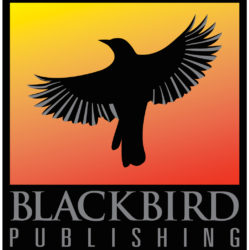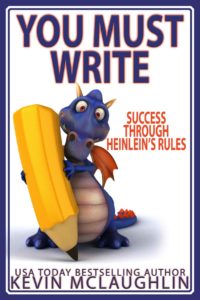
You Must Write is in the is in the NaNoWriMo Writing Tools bundle, a collection of a dozen books on writing. A portion of the proceeds goes directly to the Challenger Center for Space Science Education, a non-profit group created by the families of the crew of the Challenger shuttle. This bundle is only available through the end of November 2018.
Meet Kevin!
Kevin is an amateur astrophysicist whose hobbies include sailing, constructing medieval armor, and swinging both steel and rattan swords at his friends. He wrote his first short story at age seven, and his first novel in 2008 during NaNoWriMo.
You Must Write
No five lines of advice have built more successful writing careers than Robert Heinlein’s five rules for writers.
Whether you are new to writing or the author of many books, Heinlein’s Rules will help you bring your craft and career to the next level. This book delivers the rules in a series of practical lessons, each with exercises designed to help writers build the Rules into their own work-flow. Unlike most “writing rules”, which tend to stifle creativity, Heinlein’s Rules are focused on unleashing the most creative elements of our minds, combating our deepest and most crippling fears, and driving past the greatest obstacles most writers face to reach success.
In this book you’ll learn:
- What Heinlein’s Rules are, and how they can fit into YOUR writing career.
- Tools for better engaging your creative mind and shutting out the editorial voice while writing.
- Methods for identifying and facing down fears that block your way.
- Chapters on practical application, with examples drawn from the author’s own thirty-two-book career as a bestselling novelist.
Excerpt
The ideas in this book challenge many preconceived notions about the writing process. What you read here will fly in the face of some things you have read or been taught elsewhere. This wasn’t an easy book to write, and I expect it won’t be a simple one to read either. But it will be valuable.
There’s something about being taken outside our comfort zone which helps us to grow. Enables growth, even. It’s what we talk about in the Hero’s Journey, after all: the idea that the protagonist must go beyond their “normal world” – their comfort zone, if you will – in order to become the person they are meant to be.
I’m going to be asking you to do that inside these pages. Some of what you read here will make you uncomfortable.
But none of it is false.
If you read something that feels off to you, consider why. Think about that thing for a while. Ponder it. Try the methods suggested here. You may well find an ability to grow in your own writing practice by stepping outside your comfort zone.
There are many ways to write a book, and none of them are wrong if they eventually lead to a good book that will educate or entertain readers. In these pages I talk about one method, but I want to stress before we begin that this is only a method – not THE method. As we say, there are many roads up the mountain.
This book contains everything you need for one route. It’s a guide to reaching success as a writer that has worked for hundreds of professionals over the last seventy years. There are many ways to reach the summit – but this is a great one.
– from You Must Write by Kevin McLaughlin
The Interview
What are Heinlein’s Rules, and why do you consider them important for writers?
Heinlein wrote down five fairly simple rules for writers to follow, saying that if adhered to they would result in a successful career. Those rules?
- You must write.
- You must finish what you start.
- You must refrain from rewriting except to editorial order.
- You must put it on the market.
- You must keep it on the market until sold.
But we’re living in a time where common advice passed along over the years argues against this method. We’re told that revision is essential; but most of the professional writers before the advent of computing did not revise heavily, if at all. We’re told that it’s OK to write only when the muse is with us; but most writers who have achieved great success did so based on a strong work ethic.
That doesn’t mean these other bits of advice are always wrong. But neither are they always right. It’s important to have both sides of the story, so that we can learn which practices work best for us as individual writers.
Why are Heinlein’s Rules hard for most people to follow?
Mostly because fear is a difficult thing to overcome.
It’s fear which holds us back and keeps us from writing, most of the time. It might be fear of success or fear of failure, but it’s almost always fear. Then it’s fear which keeps us from finishing a work we’ve started. It’s not actually that the new idea is any better; we’re afraid that if we finish the book, we might find out it’s actually no good (or too good, for fear of success). It’s easier to never finish and therefore never face that fear.
It’s fear that causes us to revise over and over; because again, if we say ‘it’s done’, then we have to send the work out into the world, and what if it isn’t good enough? What if people laugh at us? What if they don’t, and they expect us to do the same thing again next book?
It’s fear which keeps us from putting our work out there where people can buy it and read it, fear which causes us to give up after a few rejections or a tiny handful of sales when indie publishing.
Fear is a harsh master to live under. The rules require we throw off that yoke. That’s what makes them hard to follow.
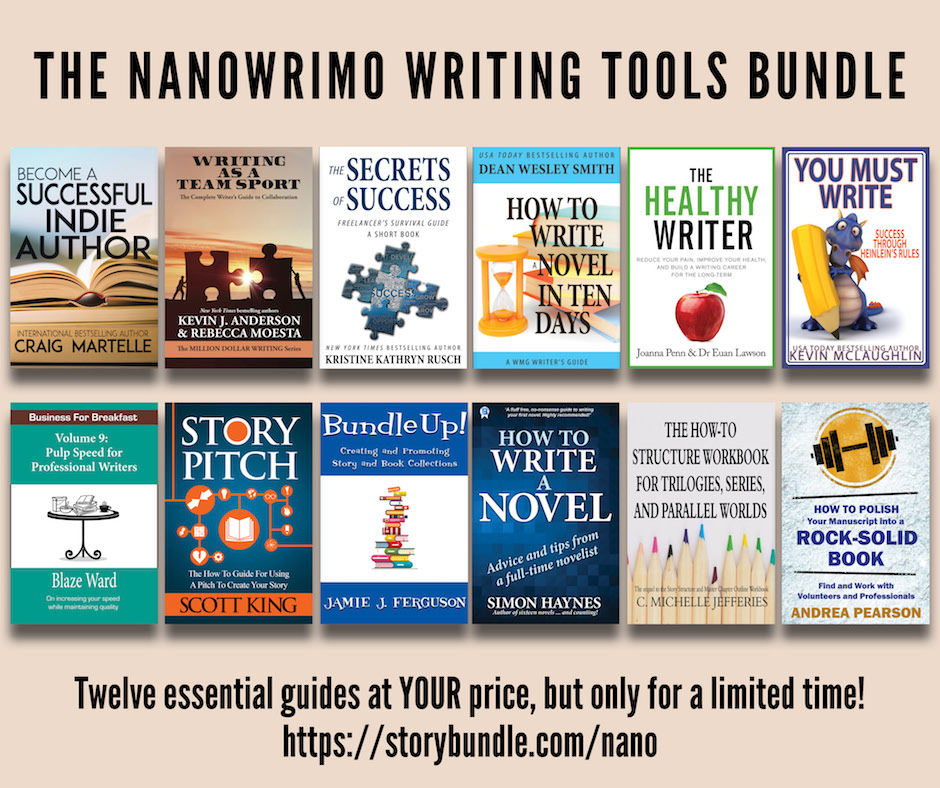
Rule #2 is “You must finish what you start.” Often, a writer will be working on a story, and then get so excited about an idea for a new story that they start working on it and never finish the first one. What tips do you have for dealing with this type of situation?
First off, just don’t do it. (chuckle) Easier said than done, I know! Oh, I get those random ideas all the time. I think most writers do. Every book I write, I seem to have at least three new ideas for something else churn up into my mind, demanding my attention.
What I used to do was write the ideas down. I’d take a notebook and put as much as I could brainstorm of the idea down onto a single page. Then I’d set the notebook down and get back to work. By writing the idea, I was telling my subconscious that I understand this new thought is important, too. That I will get to it at some point. Just not right now.
These days, I don’t even do that much. I’ve become much more ruthless about my ideas. If I have an idea for a new story in the middle of my work, I make a mental note of it and then continue working. I know part of my subconscious keeps working on the idea anyway, so I let it go. I generally have my next three or four books lined up at any given time, so if the idea is still there and still sounds exciting in a couple of months, I’ll probably slot it into my schedule somewhere. If I’ve forgotten it, then the idea probably wasn’t very good anyway.
It’s very rare that I’ll bump an idea into the middle of an existing schedule. I did it recently with the first book of a new series (“The Quantum Dragonslayer”) because I came up with the idea in part to address the trademark silliness going on in the writing community. But it’s also a really cool idea that I’m having fun with. Even then, I still waited until my current work-in-progress was completed.
Which of the Rules is the hardest one for you to follow personally, and how do you try to manage this?
The first one is the hardest for me. I suspect it is the hardest for most people.
I write pretty fast. I’m cruising along at something north of a NaNoWriMo a month, and working on getting faster – which actually means ‘spending more time hitting keys’, of course.
It’s getting there and hitting the keys that can be the hard part. It’s shutting down whatever cool science fiction TV show is attracting my attention, avoiding Facebook (the bane of all writers!), not playing silly video games on my phone, and actually getting down to work.
I erased all the games from my phone. I erased all the games from my computer. I removed all the social media apps from my phone. I installed internet blockers on my laptop, and then I go out to a coffee shop or the Boston Public Library to write. Even with all of that, it still gets hard sometimes to do as many words as I’d like!
But I persevere. With time, I will get better at this. Practice is everything.
There are currently nine books in your series Adventures of the Starship Satori. How has the series changed over time? Do you have an ending planned for the series, or do you expect to keep adding to it for the foreseeable future?
Oh, this series has changed a ton! I wrote the first bits of these books years ago when it looked like serial short works might be taking off. Each was about fifteen thousand words long. I launched them just as short serials began tanking (thanks to Kindle Unlimited changing, mostly). Then I got the idea to re-issue them as new books. I merged the first two episodes into one book and the latter three into another, then wrote a third. Now I had three novellas instead of five novelettes, and they started selling.
I made my first four-figure month thanks to those books.
But last November I took it a step further. I’d gotten better at writing in the years since they were first published, and book one was really short. Like, twenty-eight thousand words or so. I took on the challenge of rewriting the entire story, adding entire new chapters and revisiting some of the old scenes to flesh them out more. Then I relaunched them. This relaunch resulted in my first five-figure months of sales.
But wait – doesn’t that violate the Third Rule? I’d say no, for two reasons. First, because I was redrafting large chunks of the book. Redrafting (taking the old thread of an idea and writing a new version from scratch) is still writing in creative mode, rather than editorial (critical) mode. But I’d also learned over the years to split the two up. I went over the book as an editor, noting places it could be improved. Then I went back in as a writer in creative mode and improved those places. In this way I was effectively ‘revising to editorial order’. The editor said ‘make it longer’; the writer made it longer, and the book was much better as a result.
I’m not entirely sure where that series is going. I haven’t discovered yet whether Earth survives the challenges humanity is facing, and if so how. There are going to be at least twelve books before it’s all done, but it could go longer. We shall see what the story demands.
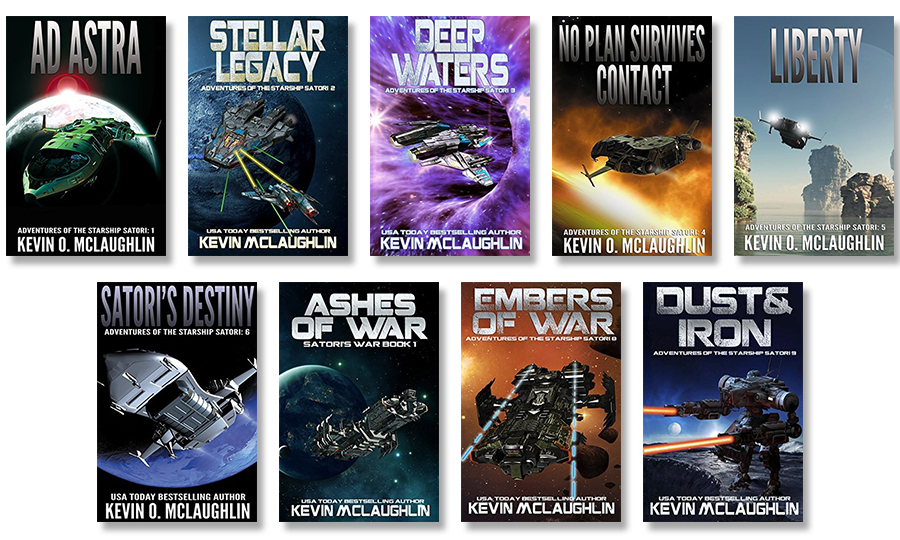
What’s the most important tip you have for following Rule #4, “You must put it on the market?”
Take the plunge and just do it. Whether you’re planning to submit the work to publishers or publish it yourself, get the work out there where people can buy it. There is a natural hesitation, especially for those first few books. Get over it. That book is not a precious flower. It is (hopefully) the first or second or third of MANY books you will write over the course of your career.
Why are backlists especially powerful for indie writers?
Well, the Starship Satori series is an awesome example. I’ve repackaged those initial stories twice now. Each time I was able to hit a new and larger audience. In fact, for the most recent relaunch (November 2017) I offered free copies of the new books to my entire mailing list. Hundreds of people took me up on the offer. I felt this was only fair, since many of them had already paid for the stories once. I didn’t want to double-charge fans to read the new versions (even though the new first book was 60% longer than the original!).
Even with the large giveaway, the relaunch was still an enormous success.
Books are evergreen. There’s no reason not to assume I can still be making money from the Satori books a decade or more from now. My backlist is mine to control, to repackage, to relaunch, to schedule push marketing around, and to do whatever else I think will get new readers.
You co-wrote The Human Experiment with Craig Martelle. What was the most surprising thing to you about the experience of collaborating with another author on this project?
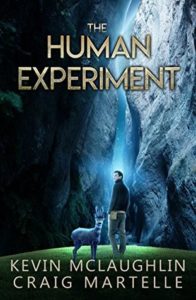 Craig was a good friend who was having trouble with this book. He’d tried working with another writer before me but it ended in failure. I took on the job because the project sounded interesting. Then I ended up getting really sick; our launch was originally supposed to be late December, and it ended up getting pushed back to April. Craig was awesome through the entire time, and I’m really grateful for that.
Craig was a good friend who was having trouble with this book. He’d tried working with another writer before me but it ended in failure. I took on the job because the project sounded interesting. Then I ended up getting really sick; our launch was originally supposed to be late December, and it ended up getting pushed back to April. Craig was awesome through the entire time, and I’m really grateful for that.
But the most surprising thing was probably the first chapter rewrite. Craig sent the finished book to some beta readers, most of whom hated the opening of the story. We chatted about it for a bit, trying to figure out how we could punch it up a bit. Midway through the conversation, I told him to give me an hour. I wrote a new first chapter that was a huge improvement over the original and shipped it out to him. He loved the new work, and did the job of massaging the other chapters to smooth it all out.
But without that feedback from the beta readers, the book would have gone out with the original opening. I think the solution we came up with works much better, and the creative process that went into the new first chapter was fascinating.
How did your hobbies, which include building medieval armor and swinging swords, help you create the setting for your Valhalla Online series?
Well, I like to think I’ve managed to add a few elements of realism as a result! I’ve got a background which includes over a decade in the US Army Infantry, about twelve years of assorted eastern martial arts, and another decade or so of western martial arts (that’s the sword and armor part). Coupled together, I use these experiences to help build realism and believability into my fight scenes and other sorts of combat scenarios.

What story (or stories) are you working on now, and what’s fun about what you’re writing?
I’m working on finishing up the fourth and final book of the Valhalla Online series. This book has been a long while coming, and I know a lot of folks are really interested in seeing how things wrap up – especially now that Sam is back in the Ghost Wing books! I’ve merged her storyline into the same universe as the Accord of Honor books, creating one big story arc out of all of them: the Ragnarok Saga. I’m enjoying the story again, which is important for me. And since I have big plans for Sam and her friends in the future (Ghost Fleet, and then other books beyond that), it’ll be fun to see how things turn out in Valhalla Online.
What’s fun about writing, for me, is keeping it fresh. If I’m getting bored, I can pretty much guarantee my readers will be as well. I’m always working to push myself in my craft, to build better stories with each book. That is a challenge, and fun. Telling stories that are fun to create is a great part of this job, too. I think if it wasn’t fun to spin these tales, I’d probably go find some other job that was, instead. Fortunately, I love this stuff!
About Kevin
Kevin McLaughlin is a USA Today bestselling author of science fiction and fantasy novels, with over thirty books published. He is a full member of SFWA, and a professional member of the RWA.
He believes in giving back to the writing community that helped him out during the early days of his career, so he uses his experience and to boost others. He has been a speaker at Boskone, Dragon Con, the Nebula Conference, 20Books London, and many other events. A skilled public speaker with experience in education, McLaughlin sees it as both pleasure and obligation to pass along to others the skills he has learned, so that the chain of people helping people continues unbroken.
Find Kevin
Website | Facebook | Twitter | Instagram | YouTube | Goodreads

Sign up for the Blackbird Publishing newsletter!
